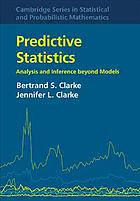Table Of ContentPredictive Statistics
AnalysisandInferencebeyondModels
All scientific disciplines prize predictive success. Conventional statistical analyses,
however,treatpredictionassecondary,insteadfocusingonmodelingandhenceon
estimation, testing, and detailed physical interpretation, tackling these tasks before
the predictive adequacy of a model is established. This book outlines a fully pre-
dictive approach to statistical problems based on studying predictors; the approach
doesnotrequirethatpredictorscorrespondtoamodelalthoughthisimportantspe-
cial case is included in the general approach. Throughout, the point is to examine
predictive performance before considering conventional inference. These ideas are
traced through five traditional subfields of statistics, helping readers to refocus and
adoptadirectlypredictiveoutlook.Thebookalsoconsiderspredictionviacontem-
porary ‘blackbox’ techniques and emerging data types and methodologies, where
conventional modeling is so difficult that good prediction is the main criterion
available for evaluating the performance of a statistical method. Well-documented
open-sourceRcodeinaGithubrepositoryallowsreaderstoreplicateexamplesand
applytechniquestootherinvestigations.
BERTRAND S. CLARKE is Chair of the Department of Statistics at the Univer-
sityofNebraska,Lincoln.Hisresearchfocusesonpredictivestatisticsandstatistical
methodologyingenomicdata.HeisafellowoftheAmericanStatisticalAssociation,
serves as editor or associate editor for three journals, and has published numerous
papers in several statistical fields as well as a book on data mining and machine
learning.
JENNIFER L. CLARKE isProfessorofFoodScienceandTechnology, Professor
ofStatistics,andDirectoroftheQuantitativeLifeSciencesInitiativeattheUniver-
sity of Nebraska, Lincoln. Her current interests include statistical methodology for
metagenomicsandalsoprediction,statisticalcomputation,andmultitypedataanal-
ysis. She serves on the steering committee of the Midwest Big Data Hub and is
Co-Principal Investigator on an award from the NSF focused on data challenges in
digitalagriculture.
CAMBRIDGE SERIES IN STATISTICAL AND
PROBABILISTIC MATHEMATICS
EditorialBoard
Z.Ghahramani(DepartmentofEngineering,UniversityofCambridge)
R.Gill(MathematicalInstitute,LeidenUniversity)
F.P.Kelly(DepartmentofPureMathematicsandMathematicalStatistics,
UniversityofCambridge)
B.D.Ripley(DepartmentofStatistics,UniversityofOxford)
S.Ross(DepartmentofIndustrialandSystemsEngineering,UniversityofSouthernCalifornia)
M.Stein(DepartmentofStatistics,UniversityofChicago)
Thisseriesofhigh-qualityupper-divisiontextbooksandexpositorymonographscoversallaspects
ofstochasticapplicablemathematics.Thetopicsrangefrompureandappliedstatisticstoprobabil-
itytheory,operationsresearch,optimization,andmathematicalprogramming.Thebookscontain
clear presentations of new developments in the field and also of the state of the art in classical
methods. While emphasizing rigorous treatment of theoretical methods, the books also contain
applications and discussions of new techniques made possible by advances in computational
practice.
Acompletelistofbooksintheseriescanbefoundatwww.cambridge.org/statistics.
Recenttitlesincludethefollowing:
20. RandomGraphDynamics,byRickDurrett
21. Networks,byPeterWhittle
22. SaddlepointApproximationswithApplications,byRonaldW.Butler
23. AppliedAsymptotics,byA.R.Brazzale,A.C.DavisonandN.Reid
24. RandomNetworksforCommunication,byMassimoFranceschettiandRonaldMeester
25. DesignofComparativeExperiments,byR.A.Bailey
26. SymmetryStudies,byMarlosA.G.Viana
27. ModelSelectionandModelAveraging,byGerdaClaeskensandNilsLidHjort
28. BayesianNonparametrics,editedbyNilsLidHjortetal.
29. FromFiniteSampletoAsymptoticMethodsinStatistics,byPranabK.Sen,JulioM.Singer
andAntonioC.PedrosadeLima
30. BrownianMotion,byPeterMörtersandYuvalPeres
31. Probability(FourthEdition),byRickDurrett
33. StochasticProcesses,byRichardF.Bass
34. RegressionforCategoricalData,byGerhardTutz
35. ExercisesinProbability(SecondEdition),byLoïcChaumontandMarcYor
36. StatisticalPrinciplesfortheDesignofExperiments,byR.Mead,S.G.GilmourandA.Mead
37. QuantumStochastics,byMou-HsiungChang
38. NonparametricEstimationunderShapeConstraints,byPietGroeneboomandGeurt
Jongbloed
39. LargeSampleCovarianceMatricesandHigh-DimensionalDataAnalysis,byJianfengYao,
ShurongZhengandZhidongBai
40. Mathematical Foundations of Infinite-Dimensional Statistical Models, by Evarist Giné and
RichardNickl
41. Confidence,Likelihood,Probability,byToreSchwederandNilsLidHjort
42. ProbabilityonTreesandNetworks,byRussellLyonsandYuvalPeres
43. RandomGraphsandComplexNetworks(Volume1),byRemcovanderHofstad
44. FundamentalsofNonparametricBayesianInference,bySubhashisGhosalandAadvander
Vaart
45. Long-RangeDependenceandSelf-Similarity,byVladasPipirasandMuradS.Taqqu
46. PredictiveStatistics,byBertrandS.ClarkeandJenniferL.Clarke
Predictive Statistics
Analysis and Inference beyond Models
Bertrand S. Clarke
UniversityofNebraska,Lincoln
Jennifer L. Clarke
UniversityofNebraska,Lincoln
UniversityPrintingHouse,CambridgeCB28BS,UnitedKingdom
OneLibertyPlaza,20thFloor,NewYork,NY10006,USA
477WilliamstownRoad,PortMelbourne,VIC3207,Australia
314–321,3rdFloor,Plot3,SplendorForum,JasolaDistrictCentre,NewDelhi–110025,India
79AnsonRoad,#06–04/06,Singapore079906
CambridgeUniversityPressispartoftheUniversityofCambridge.
ItfurtherstheUniversity’smissionbydisseminatingknowledgeinthepursuitof
education,learning,andresearchatthehighestinternationallevelsofexcellence.
www.cambridge.org
Informationonthistitle:www.cambridge.org/9781107028289
DOI:10.1017/9781139236003
©BertrandS.ClarkeandJenniferL.Clarke2018
Thispublicationisincopyright.Subjecttostatutoryexception
andtotheprovisionsofrelevantcollectivelicensingagreements,
noreproductionofanypartmaytakeplacewithoutthewritten
permissionofCambridgeUniversityPress.
Firstpublished2018
PrintedintheUnitedStatesofAmericabySheridanBooks,Inc.
AcataloguerecordforthispublicationisavailablefromtheBritishLibrary.
ISBN978-1-107-02828-9Hardback
Additionalresourcesforthispublicationatwww.cambridge.org/predictivestatistics
CambridgeUniversityPresshasnoresponsibilityforthepersistenceoraccuracyof
URLsforexternalorthird-partyinternetwebsitesreferredtointhispublication
anddoesnotguaranteethatanycontentonsuchwebsitesis,orwillremain,
accurateorappropriate.
Contents
ExpandedContents pagevi
Preface xi
PartI ThePredictiveView 1
1 WhyPrediction? 3
2 DefiningaPredictiveParadigm 34
3 WhataboutModeling? 67
4 ModelsandPredictors:ABickeringCouple 86
PartII EstablishedSettingsforPrediction 123
5 TimeSeries 125
6 LongitudinalData 161
7 SurvivalAnalysis 206
8 NonparametricMethods 249
9 ModelSelection 307
PartIII ContemporaryPrediction 359
10 BlackboxTechniques 361
11 EnsembleMethods 449
12 TheFutureofPrediction 524
References 605
Index 635
v
Expanded Contents
Preface xi
PartI ThePredictiveView 1
1 WhyPrediction? 3
1.1 MotivatingthePredictiveStance 4
1.2 SomeExamples 11
1.2.1 PredictionwithEnsemblesratherthanModels 12
1.2.2 HypothesisTestingasPrediction 21
1.2.3 PredictingClasses 26
1.3 GeneralIssues 32
2 DefiningaPredictiveParadigm 34
2.1 TheSunriseProblem 34
2.2 ParametricFamilies 41
2.2.1 FrequentistParametricCase 41
2.2.2 BayesianParametricCase 43
2.2.3 Interpretation 46
2.3 TheAbstractVersion 47
2.3.1 Frequentism 48
2.3.2 BayesApproach 51
2.3.3 SurveySampling 56
2.3.4 PredictivistApproach 58
2.4 AUnifiedFrameworkforPredictiveAnalysis 63
3 WhataboutModeling? 67
3.1 ProblemClassesforModelsandPredictors 68
3.2 InterpretingModeling 73
3.3 TheDangersofModeling 75
3.4 Modeling,Inference,Prediction,andData 78
3.5 Prequentialism 80
4 ModelsandPredictors:ABickeringCouple 86
4.1 SimpleNonparametricCases 87
4.2 FixedEffectsLinearRegression 94
4.3 QuantileRegression 101
4.4 Comparisons:Regression 104
vi
ExpandedContents vii
4.5 LogisticRegression 108
4.6 BayesClassifiersandLDA 111
4.7 NearestNeighbors 115
4.8 Comparisons:Classification 116
4.9 ALookAheadtoPartII 119
PartII EstablishedSettingsforPrediction 123
5 TimeSeries 125
5.1 ClassicalDecompositionModel 125
5.2 Box–Jenkins:FrequentistSARIMA 128
5.2.1 PredictorClassIdentification 129
5.2.2 EstimatingParametersinanARMA(p,q)Process 132
5.2.3 ValidationinanARMA(p,q)Process 133
5.2.4 Forecasting 135
5.3 BayesSARIMA 139
5.4 ComputedExamples 142
5.5 StochasticModeling 150
5.6 Endnotes:VariationsandExtensions 156
5.6.1 RegressionwithanARMA(p,q)ErrorTerm 157
5.6.2 DynamicLinearModels 159
6 LongitudinalData 161
6.1 PredictorsDerivedfromRepeated-MeasuresANOVA 167
6.2 LinearModelsforLongitudinalData 172
6.3 PredictorsDerivedfromGeneralizedLinearModels 180
6.4 PredictorsUsingRandomEffects 184
6.4.1 LinearMixedModels 184
6.4.2 GeneralizedLinearMixedModels 193
6.4.3 NonlinearMixedModels 194
6.5 ComputationalComparisons 194
6.6 Endnotes:MoreonGrowthCurves 201
6.6.1 AFixedEffectGrowthCurveModel 203
6.6.2 AnotherFixedEffectTechnique 204
7 SurvivalAnalysis 206
7.1 NonparametricPredictorsofSurvival 208
7.1.1 TheKaplan–Meierpredictor 208
7.1.2 MedianasaPredictor 216
7.1.3 BayesVersionoftheKaplan–MeierPredictor 219
7.1.4 DiscriminationandCalibration 221
7.1.5 PredictingwithMedians 222
7.2 ProportionalHazardsPredictors 226
7.2.1 FrequentistEstimatesofh0andβinPHModels 228
7.2.2 FrequentistPHModelsasPredictors 231
7.2.3 BayesPHModels 233
7.2.4 ContinuingtheExample 236
7.3 ParametricModels 239
7.4 Endnotes:OtherModels 245
viii ExpandedContents
7.4.1 AcceleratedFailureTime(AFT)Models 245
7.4.2 CompetingRisks 246
8 NonparametricMethods 249
8.1 PredictorsUsingOrthonormalBasisExpansions 252
8.2 PredictorsBasedonKernels 260
8.2.1 KernelDensityEstimation 260
8.2.2 KernelRegression:DeterministicDesigns 266
8.2.3 KernelRegression:RandomDesign 270
8.3 PredictorsBasedonNearestNeighbors 275
8.3.1 NearestNeighborDensityEstimation 275
8.3.2 NearestNeighborRegression 281
8.3.3 BeyondtheIndependenceCase 285
8.4 PredictorsfromNonparametricBayes 286
8.4.1 PolyaTreeProcessPriorsforDistributionEstimation 288
8.4.2 GaussianProcessPriorsforRegression 291
8.5 ComparingNonparametricPredictors 294
8.5.1 DescriptionoftheData,Methods,andResults 295
8.5.2 M-CompleteorM-Open? 300
8.6 Endnotes 302
8.6.1 SmoothingSplines 303
8.6.2 NearestNeighborClassification 304
8.6.3 Test-BasedPrediction 304
9 ModelSelection 307
9.1 LinearModels 312
9.2 InformationCriteria 320
9.3 BayesModelSelection 327
9.4 Cross-Validation 334
9.5 SimulatedAnnealing 339
9.6 MarkovChainMonteCarloandtheMetropolis–HastingsAlgorithm 344
9.7 ComputedExamples:SAandMCMC–MH 348
9.8 Endnotes 353
9.8.1 DIC 354
9.8.2 PosteriorPredictiveLoss 354
9.8.3 Information-TheoreticModelSelectionProcedures 355
9.8.4 ScoringRulesandBFsRedux 356
PartIII ContemporaryPrediction 359
10 BlackboxTechniques 361
10.1 ClassicalNonlinearRegression 364
10.2 Trees 368
10.2.1 FindingaGoodTree 371
10.2.2 PruningandSelection 379
10.2.3 BayesTrees 383
10.3 NeuralNets 386
10.3.1 ‘Fitting’aGoodNN 388
10.3.2 ChoosinganArchitectureforanNN 393
ExpandedContents ix
10.3.3 BayesNNs 394
10.3.4 NNHeuristics 397
10.3.5 DeepLearning,ConvolutionalNNs,andAllThat 399
10.4 KernelMethods 405
10.4.1 BayesKernelPredictors 409
10.4.2 FrequentistKernelPredictors 416
10.5 PenalizedMethods 422
10.6 ComputedExamples 429
10.6.1 DopplerFunctionExample 429
10.6.2 PredictingaVegetationGreennessIndex 433
10.7 Endnotes 443
10.7.1 ProjectionPursuit 443
10.7.2 LogicTrees 445
10.7.3 HiddenMarkovModels 446
10.7.4 Errors-in-VariablesModels 447
11 EnsembleMethods 449
11.1 BayesModelAveraging 454
11.2 Bagging 462
11.3 Stacking 471
11.4 Boosting 480
11.4.1 BoostingClassifiers 481
11.4.2 BoostingandRegression 486
11.5 MedianandRelatedMethods 489
11.5.1 DifferentSortsof‘Median’ 489
11.5.2 MedianandOtherComponents 494
11.5.3 Heuristics 495
11.6 ModelAveragePredictioninPractice 497
11.6.1 SimulationStudy 497
11.6.2 ReanalyzingtheVegoutData 507
11.6.3 MixingItUp 518
11.7 Endnotes 519
11.7.1 PredictionalongaString 520
11.7.2 NoFreeLunch 522
12 TheFutureofPrediction 524
12.1 RecommenderSystems 526
12.1.1 CollaborativeFilteringRecommenderSystems 526
12.1.2 Content-Based(CB)RecommenderSystems 530
12.1.3 OtherMethods 533
12.1.4 Evaluation 536
12.2 StreamingData 537
12.2.1 KeyExamplesofProceduresforStreamingData 538
12.2.2 SensorData 547
12.2.3 StreamingDecisions 551
12.3 Spatio-TemporalData 556
12.3.1 Spatio-TemporalPointData 559
12.3.2 RemoteSensingData 562
12.3.3 Spatio-TemporalPointProcessData 565

